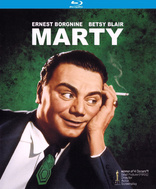Marty Blu-ray Movie
HomeMarty Blu-ray Movie 
Kino Lorber | 1955 | 94 min | Not rated | Jul 29, 2014Movie rating
7.7 | / 10 |
Blu-ray rating
| Users | 0.0 | |
| Reviewer | 3.5 | |
| Overall | 3.5 |
Overview
Marty (1955)
A middle-aged butcher and a school teacher who have given up on the idea of love, meet at a dance and fall in love.
Starring: Ernest Borgnine, Betsy Blair, Esther Minciotti, Augusta Ciolli, Joe MantellDirector: Delbert Mann
| Romance | Uncertain |
| Drama | Uncertain |
Specifications
Video
Video codec: MPEG-4 AVC
Video resolution: 1080p
Aspect ratio: 1.33:1
Original aspect ratio: 1.85:1
Audio
English: DTS-HD Master Audio 2.0 Mono (48kHz, 16-bit)
Subtitles
None
Discs
25GB Blu-ray Disc
Single disc (1 BD)
Playback
Region A (C untested)
Review
Rating summary
| Movie | 4.5 | |
| Video | 3.0 | |
| Audio | 3.5 | |
| Extras | 0.5 | |
| Overall | 3.5 |
Marty Blu-ray Movie Review
Independent film, circa 1955.
Reviewed by Jeffrey Kauffman July 13, 2014Many people consider the seventies the decade when independent film became a force to be reckoned with in American cinema, but those with longer memories might argue that the seeds for this movement were planted decades previously when a “little” film called Marty did the unthinkable, winning the Academy Award for both Best Picture and Best Actor, as well as Best Director and Best Screenplay, a feat all the more remarkable in that the film had begun life just a couple of years previously as a dramatic presentation on (gasp) television. Marty signaled a new kind of drama for American film, one that was deliberately small scale and intimate and which sought to depict the unadorned lives of working class folks who were not so insignificantly either first or second generation American immigrants. The film’s story is remarkably simple: a 34 year old butcher named Marty (Ernest Borgnine) catches regular grief from his friends and family, especially his mother, Theresa (Esther Minciotti), that he hasn’t gotten married yet. Marty knows he’s no looker, and decries himself as a “fat little man” with no prospects of ever finding a woman, content to get out of the dating game because he’s sick of having his heart broken. Nonetheless, he agrees (under duress) to attend a big dance at the Stardust Ballroom, where he meets a “dog” named Clara (Betsy Blair). The two instantly recognize a kindred spirit in each other, and a halting relationship is born. But will external reactions keep the two from achieving their own version of happily ever after?
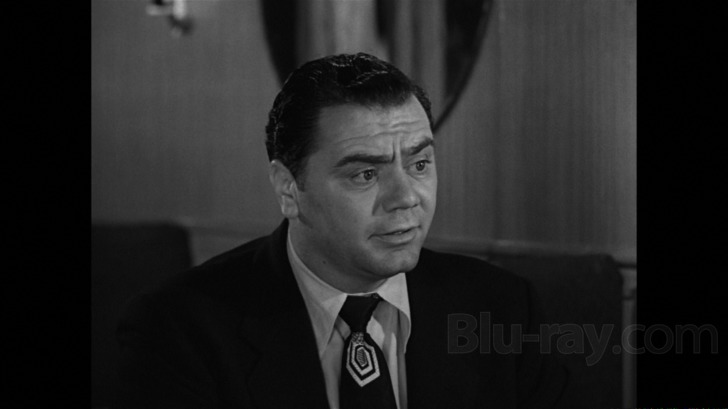
One of the interesting things about Marty is that the bulk of the film plays out over the course of one day. Marty meets with his buddy Angie (Joe Mantell) at the local watering hole as the two try to decide what to do that night. Meanwhile at home, Theresa is dealing with a family crisis involving her nephew Tommy (Jerry Paris) and his wife Virginia (Karen Steele), who are reeling under the imperious involvement of Tommy’s mother Catherine (August Ciolli), the sister of Marty’s mom, and have come to ask if Catherine can come live with Theresa and Marty. Tommy himself recommends to Theresa that she suggest Marty visit the Stardust Ballroom because it is packed with “tomatoes”. Marty also wants some advice from Tommy, an accountant, because the butcher shop’s owner has offered to sell his shop to Marty.
The longest segment in Marty details the heart rending meeting between Marty and Clara at the dance. Marty is a rather noble soul, refusing to engage in a subterfuge with Clara’s actual date, but ultimately he comes to the wounded girl’s rescue after she’s dumped by the heel she showed up with. The two dance for a while and then leave to go to a diner, where they simply sit and talk, getting to know each other. There’s a really refreshing honesty to these scenes, one that is far removed from the usual glossy treatment Hollywood affords such romances.
Things take a momentary downward turn after both of the would be lovers return home. Clara is on cloud nine as she speaks with her parents (in a scene that has been strangely excised from some home video releases of Marty), but Marty is surprised when his mother, under the influence of dour Catherine, reverses her initial approval of Clara (Marty brings the girl home to meet his mother after their talk). Will Marty let his first real chance at happiness pass him by due to the naysaying of his friends and family?
Not much “happens” in the traditional sense in Marty, but due to outstanding performances by an impeccable cast, that hardly matters. Marty doesn't play out in huge histrionics (despite some occasionally heated arguments between Tommy and Virginia). In fact two of Marty's most moving scenes are quiet (one without any actual dialogue). The first is a slow dolly into Borgnine as he receives a brush off over the phone. The second is an equally slow push into Blair when she thinks she's gotten the brush off from Marty. This is a film that speaks directly to the heart, especially to those who have ever considered themselves unworthy of happiness due to their appearance or station in life.
Marty Blu-ray Movie, Video Quality 
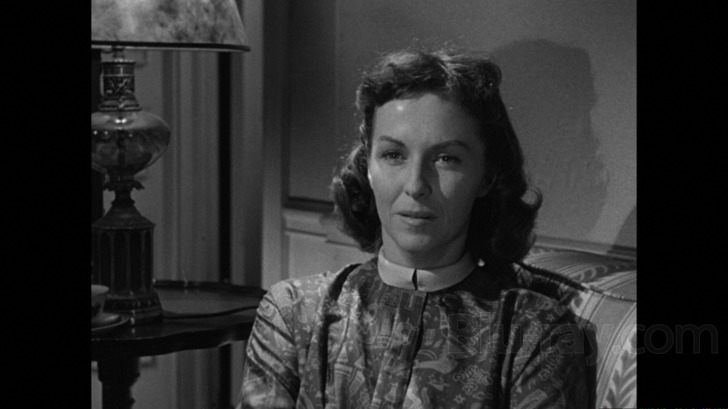
So-o-o. . .has anybody heard anything about Marty's original aspect ratio? Even before the new Blu-ray of Marty had made it to retailers, fans were up in arms over a Kino Lorber Facebook post which stated:
After examining the film elements and consulting with the studio and outside experts, we've decided to release our DVD and Blu-ray of MARTY in anamorphic 1.33:1. There is not a lot of head room in the print, and at 1.85:1 too much of the image was being cropped. So we are releasing it in 1.33:1, the preferred aspect ratio of the studio, and the ratio at which The Academy of Motion Picture Arts and Sciences screens their prints of MARTY. The original negative of this film is 1.33:1, as the title was shot open aperture, some say the bottom and top parts of the original image should be cropped off to create the intended 1.85:1 and others disagree.Though some sources are stating the new Blu-ray features a 1.37:1 aspect ratio, it is indeed 1.33:1, in 1080p and encoded via AVC. The difference between 1.33:1 and 1.37:1 is negligible, but of course the difference between 1.85:1 and 1.33:1 is quite large, and sometimes heated discussions have broken out across the internet as to what aspect ratio the film was intended to be seen in. (This in turn engenders another question: intended by whom? The director? The DP? The studio? The exhibitors?) Our own forum has had an unusually fascinating discussion about all of this, highlighted by some fantastically informational posts by the esteemed Robert Furmanek. Bob posts here about the transition from so-called Academy ratio to widescreen and how Marty was shot.
As Bob also posted here, the common practice in 1954 and 1955 when the film was in production and post production was to actually shoot in the above mentioned open aperture but to have guidelines (actual physical masking) on the view finder so that cinematographers could assess what a "matted" 1.85:1 ratio would look like. It was de rigeur therefore for cinematographers to be simultaneously keeping an eye on what would almost certainly be the projected ratio—i.e., 1.85:1—while at the same time making sure the "safety" ratio of 1.37:1 (give or take) would also look okay if things were projected "open matte". There is little doubt that Marty was projected at (or near) 1.85:1 most if not all of the time, but that doesn't necessarily mean director Delbert Mann thought that 1.37:1 (or in fact 1.33:1) was wrong. What's exacerbating this debate is the question of whether the master Kino utilized is actually a zoomed presentation, so that cropping to 1.85:1 certainly would remove important information contained within the frame.
To my eye, this does not look like a zoomed master, or perhaps I should say a traditionally zoomed master. There is no increased grain and fuzziness which usually accompanies such efforts, but more importantly the framing does not look (to me, anyway) like information is missing equally from all sides. In fact, if you pay attention you'll see the right side of the frame seems to rather regularly lop off the sides of people and objects which are at that side of the image. Watch for example during the first scene between Marty and Angie in the diner where nearly a third of Angie disappears—admittedly just for a second—while they're in the booth. (See screenshot 8. This little scene has both actors moving virtually nonstop and so it was difficult to capture a completely clear frame. While Angie is leaning slightly to his left here, both before and after this moment, the left side of his body is missing.) What's frustrating about all of this is that Kino's assertion that a 1.85:1 cropping seems "too tight" just doesn't make sense. Contrary to Kino's assertion on Facebook above, there is a lot of headroom in almost all shots, and my completely unscientific method of pressing the "display" button on my PlayStation, which as those of you with PlayStations will know adds a certain kind of masking (albeit with text) that is even wider than 1.85:1, did not omit any really important information and in fact only once or twice touched even a hair on anyone's head.
Adding even more to the controversy and perhaps confusion is the fact that the first two minutes or so (until the first hard edit) are windowboxed to an aspect ratio of 1.34:1 (see screenshots 21 and 22, and especially compare screenshot 22, just before the first hard it, with screenshot 6).
With all of this brouhaha out of the way (which, as contentious as it may have been at times, at least serves as notice of how concerned most consumers have become about aspect ratios), how does Marty actually look? Putting aside aspect ratio issues, the answer is: not bad. Not totally good, mind you, but not bad. Contrast is variable here, and as has also been discussed on our Forum, the film is quite dark a lot of the time, as has evidently been the case since its theatrical exhibition. This results in quite a bit of crush where, for example, Ernest Borgnine's jet black hair will simply melt into shadowy backgrounds. Clarity is generally average to above average (though some of this could be attributed to what looks like an older master) and the image is stable. The elements have a couple of moments of quite bad damage, but generally speaking are in serviceable shape. The "bumps" in and out of the optical dissolve at around 19:30 are badly out of focus and the entire scene between Theresa and Catherine is littered with noticeable speckling, including a pretty bad set of scratches at around 33:31.
Some will of course believe that this presentation is so fatally flawed simply because of the aspect ratio controversy that it doesn't warrant even being seen. I'd argue for all of its flaws, that this presentation is at least watchable, if far from ideal.
Marty Blu-ray Movie, Audio Quality 
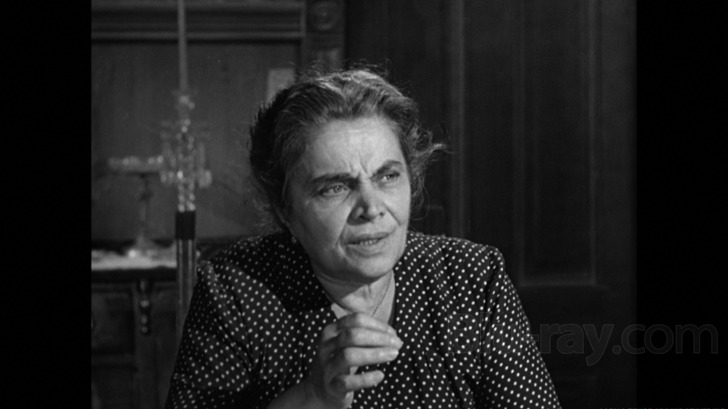
Marty's lossless DTS-HD Master Audio 2.0 mono mix suffices quite well for this largely dialogue driven film, though some audiophiles will notice just a bit of narrowness during the ballroom scenes when the brassy score by Roy Webb (trafficking in the then very popular Latin rhythms like Mambo) is playing. Other than that anomaly, there are no age related issues to discuss.
Marty Blu-ray Movie, Special Features and Extras 
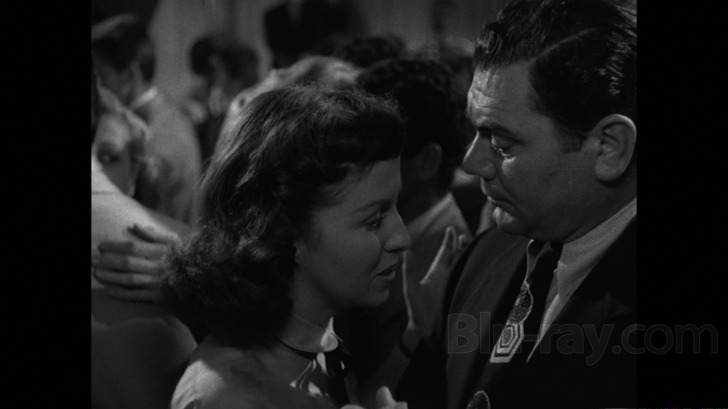
- Trailer (1080p; 2:59)
Marty Blu-ray Movie, Overall Score and Recommendation 
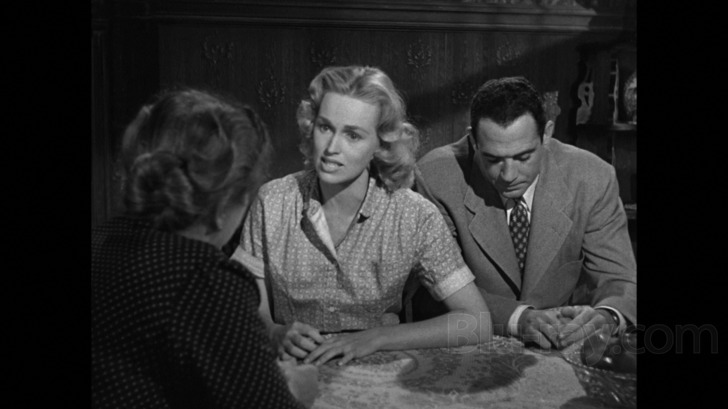
Marty is an unquestioned classic of American cinema, and every film lover should really see it at least once in their "careers". This Blu-ray has questionable issues surrounding the video presentation, and so each consumer will have to decide for him- or herself whether this is a fatal flaw or not. From a standpoint that this is all the Marty we have thus far, as I mentioned above, this is at least watchable with no overt framing issues other than a whale of a lot of headroom in a lot of shots and some occasionally missing information at the far right side of the frame.
Similar titles
Similar titles you might also like

Two for the Seesaw
1962

Picnic
Limited Edition to 3000 - SOLD OUT
1955

You're a Big Boy Now
Warner Archive Collection
1966

Stella Dallas
1937

Kitty Foyle
1940

Hobson's Choice
1954

Moscow on the Hudson
Limited Edition to 3000
1984

The Farmer's Daughter
1947

Magic Town
1947

The Best of Everything
Limited Edition to 3000
1959

The Gilded Lily
1935

Big Eden
2000

Daisy Kenyon
1947

Remember the Night
1940

Young Man with a Horn
Young Man of Music / Warner Archive Collection
1950

Jezebel
Warner Archive Collection
1938

Separate Tables
1958

Mr. Deeds Goes to Town
80th Anniversary Edition
1936

The Garden of Allah
1936

Ten North Frederick
Limited Edition to 3000
1958
